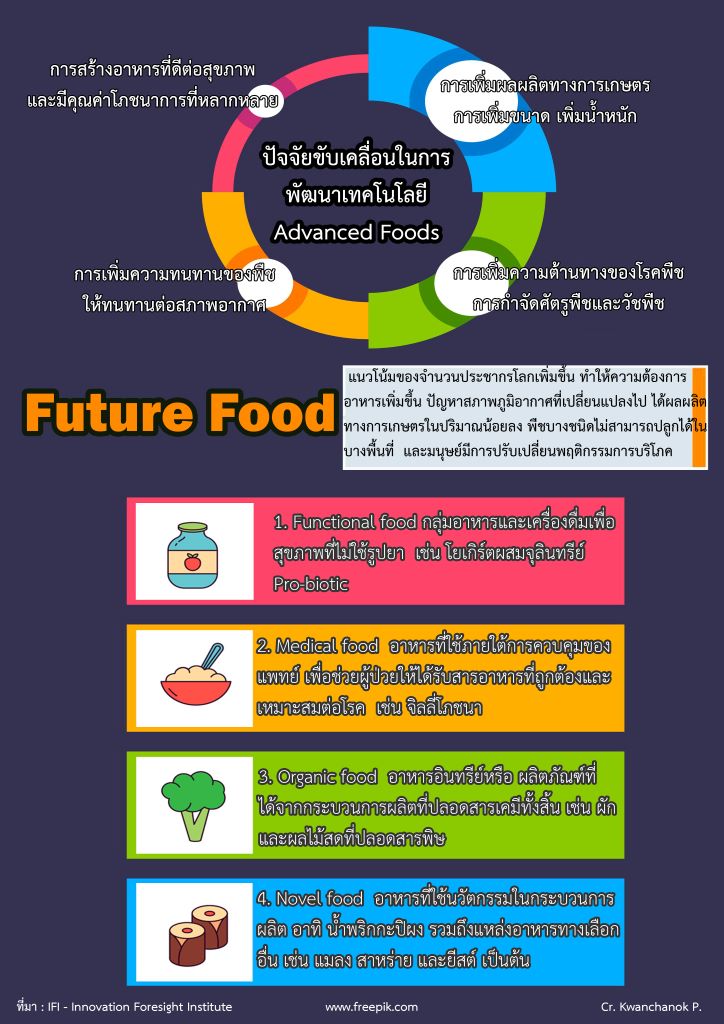Future Food อาหารแห่งอนาคต โปรตีนทางเลือก โอกาสของเกษตรกรไทย
วินัย มะหะหมัด*
บรรณารักษ์ชำนาญการ
สำนักหอสมุด มหาวิทยาลัยเกษตรศาสตร์

แนวโน้มของโลกจำนวนประชากรเพิ่มขึ้น ความต้องการอาหารเพิ่มขึ้น เทคโนโลยีทางการแพทย์สมัยใหม่ช่วยให้มนุษย์มีอายุยืนยาว ปัญหาสภาพภูมิอากาศที่เปลี่ยนแปลงไปอย่างรุนแรง ได้ผลผลิตทางการเกษตรในปริมาณน้อยลง ด้วยอากาศร้อนขึ้น พืชบางชนิดไม่สามารถปลูกได้ในบางพื้นที่ บางแห่งไม่สามารถดำเนินการเพาะปลูกผลิตอาหารได้เช่นเดิม จากแปลงเกษตรแบบเปิด ต้องเปลี่ยนเป็นการเพาะปลูกในโรงเรือนมากขึ้น และจากที่มนุษย์มีการปรับเปลี่ยนพฤติกรรมกับการทำงานที่ต้องอยู่ฟาร์ม เป็นคนเมืองอยู่ในออฟฟิสไม่ต้องใช้พลังงานมาก การปรับเปลี่ยนการบริโภคคาร์โบไฮรเดรตและน้ำตาลจึงลดลง วิถีชีวิตการบริโภคจึงเปลี่ยนไป เป็นการเลือกโปรตีนทางเลือกจากพืช และแมลงจึงได้รับความนิยมมากขึ้น สิ่งเหล่านี้จึงเป็นปัจจัยที่ส่งผลกระทบต่อการพัฒนาอาหารรูปแบบใหม่ เพื่อให้มีอาหารที่เพียงพอกับความต้องการของประชากรที่เพิ่มขึ้น หากกล่าวถึงการผลิตอาหารปัจจุบัน อาหารแห่งอนาคต หรือ Future Food เป็นเรื่องที่ได้รับความสนใจ แต่ยังไม่เป็นที่รู้จักอย่างแพร่หลาย ซึ่งปัจจุบันจะเห็นว่ามีผลิตภัณฑ์อาหาร และเครื่องดื่มที่เรียกว่า Future Food อยู่ใกล้ตัวมีให้เลือกซื้อตามท้องตลาดซูเปอร์มาเก็ต และร้านสะดวกซื้อทั่วไป เช่น อาหารอินทรีย์ / โยเกิร์ตผสมจุลินทรีย์ Bro-biotic วิตามินซีที่มีส่วนผสมขมิ้นและพริกไทยดำ เป็นต้น
ดังนั้นผู้รวบรวมจึงสนใจที่จะนำเสนอแหล่งทรัพยากรสารสนเทศออนไลน์ที่สำนักหอสมุดมีให้บริการ ในเรื่อง อาหารแห่งอนาคต หรือ Future Food หากกล่าวถึง อาหารอนาคตแล้ว มักจะพบคำที่เกี่ยวข้องเหล่านี้ ได้แก่
(1) Functional food (กลุ่มอาหารและเครื่องดื่มเพื่อสุขภาพที่ไม่ใช้รูปยา) อาทิ โยเกิร์ตผสมจุลินทรีย์ Pro-biotic
(2) Medical food (ผลิตภัณฑ์ที่ไม่ใช้ยาหรืออาหารเสริม) อาทิ จิลลี่โภชนา อาหารพระราชทานจากล้นเกล้ารัชกาลที่เก้าเพื่อผู้ป่วยโรคมะเร็งช่องปาก
(3) Organic food (อาหารอินทรีย์หรือ ผลิตภัณฑ์ที่ได้จากกระบวนการผลิตที่ปลอดสารเคมีทั้งสิ้น)
(4) Novel food (อาหารที่ใช้นวัตกรรมในกระบวนการผลิต) อาทิ น้ำพริกกะปิผง เพียงแค่เติมน้ำก็สามารถรับประทานได้ รวมถึงแหล่งอาหารทางเลือกอื่น เช่น แมลง สาหร่าย และยีสต์ เป็นต้น
โดยใช้ดัชนีคำเหล่านี้สืบค้น Alternative Proteins (โปรตีนทางเลือก), insect-based protein (โปรตีนจากแมลง), Plant-based protein (โปรตีนจากพืช) จากฐานข้อมูล Scopus พร้อมคัดสรรแหล่งสารสนเทศสนเทศออนไลน์ที่เกี่ยวข้องให้ได้เลือกอ่าน เพิ่มเติมได้จากที่มา แหล่งอ้างอิงที่เกี่ยวข้องแนบท้ายนี้
Keyword ที่น่าสนใจ : Plant-based products (ผลิตภัณฑ์จากพืช) , Novel proteins (นวัตกรรมอาหาร) , Meat analog/ Simulated meat (เนื้อเทียม), Sustainable diets (อาหารที่ยั่งยืน) , Meat alternative/ Meat analogues (อาหารทดแทนเนื้อสัตว์) , Microalgae proteins (โปรตีนจากสาหร่ายเซลเดียว) , Food sustainability (อาหารที่ยั่งยืน) , Food Security (ความมั่นคงทางอาหาร)
ที่มาแหล่งอ้างอิงที่เกี่ยวข้อง
2030 จับตาอนาคตอาหารโลก. (2563). Retrieved from https://blog.pttexpresso.com/future-food-2030/ , 5 ตุลาคม 2563
สำนักงานส่งเสริมการค้าในต่างประเทศ ณ เมืองดูไบ. (2563). รายงานข่าวประจำสัปดาห์: อาหาร Plant based foods เทรนด์
อาหารมาแรงในสหรัฐอาหรับเอมิเรตส์. Retrieved from https://www.ditp.go.th/ditp_web61/article_sub_view.php?
filename=contents_attach/659081/659081.pdf&title=659081&cate=414&d=0 , 9 ตุลาคม 2563
Bazoche, P., and S. Poret. (2020). Acceptability of insects in animal feed: A survey of French consumers. Journal
of Consumer Behaviour. doi:10.1002/cb.1845
Castro Delgado, M.,E. Chambers,A. Carbonell-Barrachina,L. Noguera Artiaga,R. Vidal Quintanar, and A. Burgos Hernandez.
(2020). Consumer acceptability in the USA, Mexico, and Spain of chocolate chip cookies made with partial
insect powder replacement. Journal of Food Science, 85(6), 1621-1628. doi:10.1111/1750-3841.15175
de Koning, W.,D. Dean,F. Vriesekoop,L. K. Aguiar,M. Anderson,P. Mongondry,M. Oppong-Gyamfi,B. Urbano,C. A. G.
Luciano,B. Jiang,W. Hao,E. Eastwick,Z. J. Virgil, and A. Boereboom. (2020). Drivers and inhibitors in the
acceptance of meat alternatives: The case of plant and insect-based proteins. Foods, 9(9).
doi:10.3390/foods9091292
Fasolin, L. H.,R. N. Pereira,A. C. Pinheiro,J. T. Martins,C. C. P. Andrade,O. L. Ramos, and A. A. Vicente. (2019).
Emergent food proteins – Towards sustainability, health and innovation. Food Research International, 125.
doi:10.1016/j.foodres.2019.108586
Gómez-Luciano, C. A.,L. K. de Aguiar,F. Vriesekoop, and B. Urbano. (2019). Consumers’ willingness to purchase
three alternatives to meat proteins in the United Kingdom, Spain, Brazil and the Dominican Republic.
Food Quality and Preference, 78. doi:10.1016/j.foodqual.2019.103732
Grasso, A. C.,Y. Hung,M. R. Olthof,W. Verbeke, and I. A. Brouwer. (2019). Older consumers’ readiness to accept
alternative, more sustainable protein sources in the European Union. Nutrients, 11(8). doi:10.3390/nu11081904
Holmes, L. A.,S. L. Vanlaerhoven, and J. K. Tomberlin. (2017). Photophase Duration Affects Immature Black Soldier
Fly (Diptera: Stratiomyidae) Development. Environmental Entomology, 46(6), 1439-1447. doi:10.1093/ee/nvx165
Ismail, I.,Y. H. Hwang, and S. T. Joo. (2020). Meat analog as future food: A review. Journal of Animal Science and
Technology, 62(2), 111-120. doi:10.5187/jast.2020.62.2.111
Mazac, R., and H. L. Tuomisto. (2020). The post-anthropocene diet: Navigating future diets for sustainable food
systems. Sustainability (Switzerland), 12(6). doi:10.3390/su12062355
Mok, W. K.,Y. X. Tan, and W. N. Chen. (2020). Technology innovations for food security in Singapore: A case study
of future food systems for an increasingly natural resource-scarce world. Trends in Food Science and Technology,
102, 155-168. doi:10.1016/j.tifs.2020.06.013
Nugroho, R. A., and F. M. Nur. (2018). Insect-based protein: Future promising protein source for fish cultured. Paper
presented at the IOP Conference Series: Earth and Environmental Science.
Roffeis, M.,J. Almeida,M. E. Wakefield,T. R. A. Valada,E. Devic,N. Koné,M. Kenis,S. Nacambo,E. C. Fitches,G. K. D. Koko,
E. Mathijs,W. M. J. Achten, and B. Muys. (2017). Life cycle inventory analysis of prospective insect based feed
production in West Africa. Sustainability (Switzerland), 9(10). doi:10.3390/su9101697
Sha, L., and Y. L. Xiong. (2020). Plant protein-based alternatives of reconstructed meat: Science, technology, and
challenges. Trends in Food Science and Technology, 102, 51-61. doi:10.1016/j.tifs.2020.05.022
Tamayo Tenorio, A.,K. E. Kyriakopoulou,E. Suarez-Garcia,C. van den Berg, and A. J. van der Goot. (2018). Understanding
differences in protein fractionation from conventional crops, and herbaceous and aquatic biomass -
Consequences for industrial use. Trends in Food Science and Technology, 71, 235-245.doi:10.1016/j.tifs.2017.11.010
Tian, J.,B. C. Bryksa, and R. Y. Yada. (2016). Feeding the world into the future – food and nutrition security: the role
of food science and technology†. Frontiers in Life Science, 9(3), 155-166. doi:10.1080/21553769.2016.1174958

